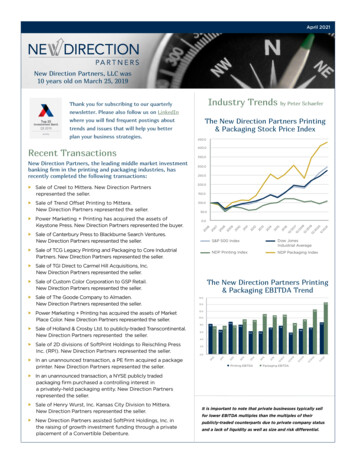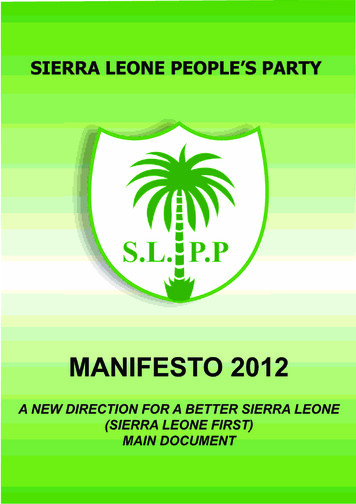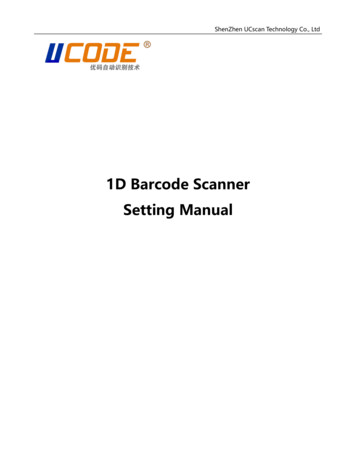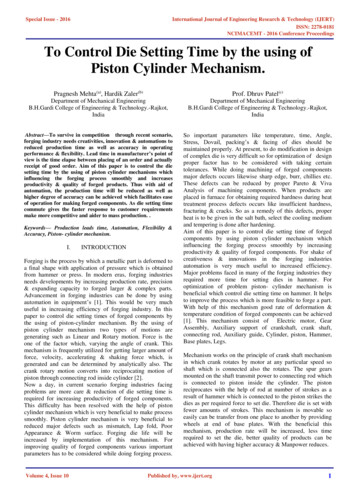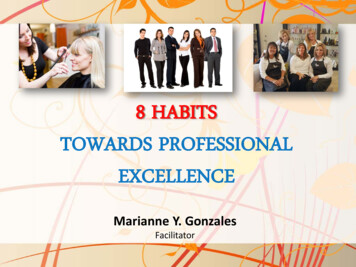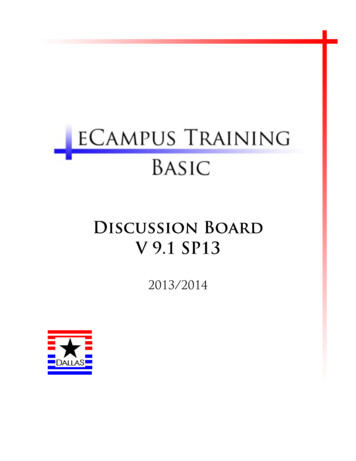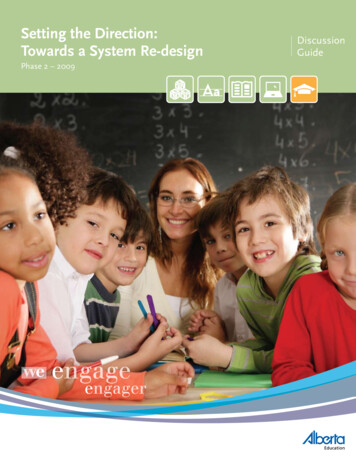
Transcription
Setting the Direction:Towards a System Re-designPhase 2 – 2009DiscussionGuide
ALBERTA EDUCATION CATALOGUING IN PUBLICATION DATAAlberta. Alberta Education.Setting the direction towards a system re-design.Also available online at www.education.alberta.caISBN 978-0-7785-7537-51. Special education – Alberta. 2. Children with disabilities –Education – Alberta.3. Students with disabilities – Education – Alberta. I. Title.LC3984.2.A3 A333 2009371.904
Message from the Minister of EducationAs Setting the Direction for Special Education in Alberta enters the second phase ofconsultation, I have the good fortune to be Minister of Education at such a dynamic time foreducation in Alberta.During Phase 1 consultations, approximately 3,500 Albertans provided insight into visionand principles for a new special education framework in Alberta. Contributions were clear,consistent and direct. Teachers echoed the passion of parents who echoed the passion ofschool board trustees and so on. All spoke of systemic change where all students are providedwith the supports, programs and services they need to be successful. Input set a positivetone to allow the Steering Committee, Stakeholder Working Group and Project Team to thinkconstructively to develop the vision, mission and principles for this initiative and options forchanges to the system.Phase 2 will provide Albertans with an opportunity to consider a system that nurtures the visionand principles while supporting an increasingly diverse student population. During this phase,you will clearly identify what the preferred future looks like in relation to the vision, missionand principles. This is a time for you to roll up your sleeves and contribute further insight intosystem re-design. There are many ways to be involved in Phase 2 consultations as individuals orgroups representing a particular interest or segment of the population.I am looking forward to working with you as Setting the Direction and other Educationinitiatives inform and influence how we serve Alberta’s children and students.Dave Hancock, QCMinister, Alberta EducationP.S. As Phase 2 of Setting the Direction gets underway, Phase 1 of Inspiring Education: ADialogue with Albertans will begin. Setting the Direction and Inspiring Education are aboutlistening to as many points of view as possible and learning from community input intothe projects. I want to assure you that your contributions to Setting the Direction will notbe lost. Outcomes from Setting the Direction will be integrated into Inspiring Education toallow for a more complete conversation about the education system as a whole and whatthis means for the 21st century learner.1
Purpose of this Discussion GuideSetting the Direction for Special Education in Alberta is a major Alberta Education projectdesigned to create a new framework that will help students with special needs receive theeducation necessary to be successful. Phase 1 of the project reviewed the effectiveness ofour current approach and then focused on defining a vision and principles to guide the futuredirection of special education in Alberta. Input was received from 3,500 individuals and groupsin public consultation sessions and through online responses to the Phase 1 discussion guide.Albertans told us that there are many challenges in understanding and supporting the abilitiesand needs of an increasingly diverse educational population.Input from Phase 1 participants has been summarized in a Phase 1 Community Consultation WhatWe Heard Summary Report document. This document is available online or in print through www.settingthedirection.alberta.ca or by calling 780-643-0834 or e-mailing setting.direction@gov.ab.ca.This discussion guide is intended to shape our conversations with Albertans in Phase 2. We’dlike you to answer the questions in each section, and return the Guide to us. Details about ourconsultation sessions, and the ways in which you can be involved, are on page 21.Glossary of TermsAssessment means the ongoing process of collecting information about students using anumber of formal and informal methods across a variety of domains relevant to performance(behavioural, communicational, intellectual, learning or physical characteristics) to develop andimplement appropriate programming to support student learning.Accessible means readily available to the individual or group of interest, with minimalconstraints or barriers and may apply to information, knowledge, services and classroomresources.Assistive Technology for Learning (ATL) is defined as the devices, media and services usedin learning environments to overcome barriers for students with physical, sensory, cognitive,speech, learning or behavioural special needs to actively engage in learning and to achieve theirindividual learning goals.Authorized learning and teaching resources means instructional and student resources thathave been reviewed by Alberta Education and found to support the Programs of Study.Children and Youth Services means the Alberta Department of Children and Youth Services.Collaboration is a mutually beneficial and well-defined relationship entered into by two or moreindividuals or organizations to achieve common goals. The relationship includes a commitmentto: a definition of mutual relationships and goals; a jointly developed structure and sharedresponsibility; mutual authority and accountability for success; and sharing of resources andrewards.Curriculum is a broad term that includes the Programs of Study, authorized learning andteaching resources, and provincial assessments.Differentiated instruction means creating multiple paths so that students of different abilities,interest or learning needs experience equally appropriate ways to learn, use and presentconcepts.2Disability is used from the standpoint of the Supreme Court of Canada having established thata disability may be the result of a physical limitation, an ailment, a perceived limitation or acombination of all these factors. The focus is on the effects of the preference, exclusion or othertype of differential treatment experienced by the person and not on proof of physical limitationsor the presence of an ailment.
Diversity and diverse learners describes the wide range of abilities, interests, backgrounds,languages, cultures and religions reflected in Alberta’s classrooms today. Diversity has becomeone of the defining features of Alberta’s schools.Early Childhood Services (ECS) refers to a continuum of programming that is developmentallyappropriate and meets the diverse needs of young children and their families. Kindergartenrefers specifically to the education program for children in the year prior to Grade 1 and is a partof the ECS continuum. In Alberta, the term “child” rather than “student” is used for learners inECS programs.Education means the Alberta Department of Education.Education specialist means a teacher with expertise and experience in a specific field ofeducation, such as reading instruction or teaching children with visual impairments, whosupports other teachers.Educational success means students have acquired a range of skills and competencies neededto become the best they can be as adults, including interpersonal skills, academic skills,vocational competency, citizenship and health.Framework in this document means an organized set of interrelated ideas including vision,mission and principles for policy, accountability and funding to support the future of specialeducation in Alberta.Health and Wellness means the Alberta Department of Health and Wellness.Home Education Program means a program where a parent assumes the responsibility for theplanning, the provision and the evaluation of an education program for their child in Grades1 – 12. Home education is conducted in association with a public school board or an accreditedprivate school.Inclusive education refers to system-wide values that promote belonging and create the bestlearning opportunities for all students, including students with disabilities.Individualized Program Plan (IPP) means a concise plan of action designed to address students’special education needs, and is based on diagnostic information which provides the basis forintervention strategies.Learner describes anyone who is learning; it includes students and children in ECS programs,and can include teachers, parents and others.Learning coach means a mentor and facilitator who engages in personalized interaction withthe teacher, and uses effective communication and feedback tools, works to create a sense ofcommunity, provides support and encouragement, and enhances learning in the school.Learning team or Support team means all school authorities will adopt system-wide valuesthat promote belonging and create the best learning opportunities for all students, includingstudents with disabilities. This concept does not limit student and parental choice of schoolauthority or school placement.One inclusive education system means all school authorities will adopt system-wide valuesthat promote belonging and create the best learning opportunities for all students, includingstudents with disabilities. This concept does not limit student and parental choice of schoolauthority or school placement.Paraprofessional means a trained worker who works under the supervision of a professional butdoes not have professional credentials; in education paraprofessionals are usually referred to asteacher assistants or educational assistants.Personalized learning focuses on the strengths of the student and addresses not just what thestudent needs to do but also what the system needs to do to promote better learning opportunities3
for each particular student. A personalized learning profile identifies learning needs and theresources and supports needed to meet them.Programs of Study identify what students are expected to learn and do in all subjects and grades andinclude both broad and specific outcomes.Program assessments are measures to determine the degree to which students have achieved theoutcomes of the Programs of Study.Province means the Government of Alberta and in those instances where we mean AlbertaEducation, reference will be made specifically to Alberta Education.Resources are things that can be used for support or help and can be drawn on when needed.Resources can include learning and teaching resources, human resources, and financial resources.School administration means the school principal, assistant principal and other staff members inadministrative roles.School authority is a term that includes public and separate school jurisdictions, Francophoneschool authorities, charter and private schools.Student in Alberta refers to learners in grades 1 to 12.SuperNet is a government initiative designed to provide high-speed, broadband access to publicfacilities (and through service providers, to businesses and residences) in Alberta communities.Support team or Learning team means a team that consults and shares information relevant to theindividual student’s education and plans, implements and evaluates special education programmingand services as required. The team may consist of the classroom teacher, parents, students (whereappropriate), other school and jurisdiction staff aware of the students’ needs, and others as required.System re-design means an evaluation of the existing design by breaking it down into its basicbuilding blocks. These are analyzed to determine whether they continue to be relevant for learningin the future, or if they need alteration or replacement.Teaching Quality Standard refers to Ministerial Order (#016/97) Teaching Quality Standard Applicableto the Provision of Basic Education in Alberta, which includes descriptors of skills knowledge andattributes required by teachers. Link - iversal Design for Learning (UDL) is a set of principles that guide the design of flexiblelearning environments, resources and activities to accommodate individual learning differences.UDL is intended to increase access to learning by reducing physical, cognitive, intellectual andorganizational barriers to learning, as well as other obstacles. A UDL approach calls for creatingcurriculum, learning environments and resources from the outset that provide multiple meansof representation to give learners various ways of acquiring information and knowledge; multiplemeans of expression to provide learners alternatives for demonstrating what they know; and multiplemeans of engagement to tap into learners’ interests, challenge them appropriately, and motivatethem to learn.Wraparound is a philosophy of care that includes a definable planning process involving the child/student and family that results in comprehensive, coordinated supports and services to achieveimproved learning outcomes and improved quality of life. Coordinated services and supports,offered through multiple professionals and agencies that are school based and/or school linked,might include health and mental health related services, mentoring, before/after school programs,and other supports and services for parents and families. “Full service schools” is another termoften linked to a wraparound approach.4
IntroductionPhase 1 of the Setting the Direction consultation process yielded very valuable input. It isimportant to note that Albertans told us that parts of our current system work well and should notbe lost in a new framework. There was an appetite for considerable change and improvement inthe system and we have identified the following elements as key ingredients of our new future: We still need to guarantee disability* rights of those individuals with mental and physicaldisabilities as set out in the Canadian Charter of Rights and Freedoms and in the AlbertaHumans Rights, Citizenship and Multiculturalism Act. We will continue to need assessment of students’ abilities and needs, so we can understandtheir educational implications, and design the best learning opportunities for students in safeand caring schools.*The presence of the word We will still need to collect meaningful data to enable to us to track student“disability” in our materialslearning, supports and services and to identify training and resource needshas been raised as a potentialof the learning team, school authorities and province.issue. We appreciate the factthat this word may reinforce We must continue to work collaboratively for the best learninga perception of thoseopportunities for the individual student and for the best learningwith special needs that isopportunities for all students.inconsistent with the directionproposed in this document. We will continue to need policy direction, standards, and accountabilityWe do, however, use the wordmeasures that reinforce our vision and principles.consciously. Legal advicehas recommended that we We must continue to support children in Early Childhood Servicescontinue to use the termprograms and ensure smooth transitions into the Grade 1 to 12 system.disability as a precautionThe Phase 1 consultation message was clear: to address the concerns raisedto ensure protection underby Albertans, minor changes to the current system of special educationSection 15 of the Charterwill not be acceptable to our stakeholders. A new framework will need toof Rights and Freedoms,recognize and respond to diversity across students, schools and schoolwhich guarantees equalityauthorities in the province. While considering the possibilities for ato all, including those withnew future as outlined in this document we must also take into accountdisabilities (see page 7). Thethat change of this magnitude will have impact across all aspects of theuse of the word disability ineducation system – and that no one stakeholder, even the Government ofour materials, is not designedAlberta, has the ability to create systemic change single-handedly.in any way to diminish theintent of this discussionIt is a generally held perception in Alberta that special education focusesguide which imagines aon individual student deficits, rather than their educational strengths andsingle educational systemabilities, and identification is usually based on failure to succeed in theresponsive to the distinctiveclassroom. There is also the perception that when students do not learn inneeds of all students.the same way as the majority of their peers, they are somehow consideredto have faults. The approach has been to use a health model focusingon medical diagnosis (which may or may not have educational relevance), translate thesedisabilities into special education codes, and allocate funding and other resources based on thecodes. Students are then labeled by their disabilities, a practice that has been described as bothdemeaning and limiting. Currently in special education, if a student is not labeled, the neededresources and accommodations may not be available. We heard that too much time and moneyis spent on diagnosing, assessing and coding students for funding purposes and this divertsresources away from meeting the educational needs of students.Funding came up repeatedly in Phase 1 – issues of inadequate funding, inflexible funding orproblematic access to funding. Creating a revised funding mechanism will be a key element of thenew framework that comes forward in Phase 3, but before we propose funding allocations, we feltit was critical to get agreement on the elements of our proposed future. Albertans will be invitedto respond to the Framework in Phase 3 by addressing how we might spend the money availableto us more effectively for students.5
Participants in the Phase 1 consultations described the current Alberta education system asineffective or deficient in supporting education for ALL students. The perspectives gainedfrom Phase 1 participants described the special education system as distinct from, and runningparallel to, the larger Alberta education system. Albertans stated that it is not possible to createa new framework for special education in isolation. Therefore, our work in Phase 2 is to startthinking about those elements, or building blocks, that contribute to one education system andidentify those things that need to change to support education for all students.In addition, we must also be mindful that our education system supports Early ChildhoodService (ECS) and transitioning beyond the Grade 1-12 system. We cannot think about changeor possibilities for a new future without taking these important aspects of education intoconsideration. Phase 2 of this project is called Setting the Direction: Towards a System Re-design –and it starts with a vision.Setting the Direction: Vision, Mission, PrinciplesThe Phase 1 process has made it clear that improvements to the current system will notbe adequate. Therefore, the Vision and Mission and Principles, derived from the Phase 1consultation, for the Setting the Direction initiative are:Setting the Direction VisionOne inclusive education system where each student is successful.One inclusive education system means all school authorities will adopt system-wide values that promote belongingand create the best learning opportunities for all students, including students with disabilities.Setting the Direction MissionBuild one inclusive education system that makes it possible for all students to belong, andwhere the best learning opportunities are provided for each student. This system will be basedon integrity, respect for difference and a focus on each student’s assets.Setting the Direction PrinciplesWorking with the principles of Alberta Education, which are: Student Centred, Leadership,Accessible, Responsive, Innovative, Collaborative, Equitable and Accountable, Setting theDirection’s principles are:Alberta Education and its stakeholders believe: That all students can learn and be successful. That when all stakeholders work together in a collaborative and purposeful way, we accomplishmore for students. In inclusion as a value system that promotes belonging and creates the best learningopportunities for all students, including students with disabilities. Inclusion goes beyond theidea of classroom integration.Alberta Education and its stakeholders value: An education system that is fair, appropriately-resourced and offers equitable opportunities to allstudents. Diversity as a positive and enriching aspect of Alberta’s education system.6 The learning that happens for everyone when students with disabilities are effectively included inschool life.
Parents as vital members of the learning team who contribute important expertise and insights.Alberta Education and its stakeholders commit to: Working together for the success of each student in an inclusive education system. Ensuring students and families are respected and supported so they can be successful. Ensuring teachers and school systems are supported so they are able to create successfullearning opportunities. Being learner-centred in all of our decisions.These statements of Vision, Mission and Principles for Setting the Direction will guide all ofour work on this initiative, and will inform the development of the new framework in Phase 3.Another broad-based initiative is underway: Inspiring Education: A Dialogue with Albertans, andit, like Setting the Direction, is about listening to as many points of view as possible and learningfrom community. While Setting the Direction has a vision, mission and principles for specialeducation, Inspiring Education will invite a conversation about a vision, mission and principlesfor the 21st Century learner. To ensure that these projects dovetail, outcomes from Setting theDirection will be integrated into Inspiring Education.Overarching principles to consider for one inclusiveeducational systemThere are some legal limits on the process of educational change but the proposed redesignof the system described in this discussion guide falls within those parameters. Section 15 ofthe Canadian Charter of Rights and Freedoms guarantees equality to all, including those withdisabilities. This constitutional mandate applies to all public and separate schools. Thesesame rights of equality for people with disabilities are guaranteed in the Alberta Human Rightsand Citizenship and Multiculturalism Act, and that statute applies to all schools - be they publicor private. Thus educational services must be provided to all students in a way that does notdiscriminate against persons with disabilities. Given the wide range of school authoritiesin Alberta and the high value placed on educational choice, we should have a system thatsupports choice for everyone. Thus the single inclusive system approach to education shouldbe embraced in all Alberta schools. The proposed single inclusive education system is alsoconsistent with the statutorily sanctioned value of diversity, currently stated in the Alberta SchoolAct. This re-design of the educational system is the logical extension of both the letter and thespirit of the Canadian Constitution and the laws of Alberta.7
Five Building Blocks for ChangeWhen we talked with Albertans (either in person or through the website) in Phase 1, they saidthat there are a number of things that needed to be considered in a new future for an inclusiveeducation system. We have taken your good advice, along with the advice of academic expertsin this field and an analysis of the research that exists in this discipline and developed whatwe believe are FIVE critical building blocks that could herald positive and important change inAlberta. These are:1. Setting High Expectations for ALL Students2. Using Strengths and Abilities to Drive Programming3. Building Capacity for School-Based Staff and the Learning Team4. Collaborating for Learner Success5. Accessing Learning Resources and Technologies for the 21st CenturyWithin each of these “building blocks”, a desired outcome (or a description of a future state)is included. In addition, there is in each section, a collection of ideas that could be consideredas ways to make the change possible and to deliver on the vision for one inclusive educationsystem. In time, these could become strategies to arrive at the outcome, but at the moment, theyare possibilities for you to consider.A system redesign, like a house redesign, will require a bit of demolition and a lot of planningand building. We are in Phase 2 of our planning and building.The results of the Phase 2 discussions will inform the new framework (Phase 3) - onethat consists of Vision, Mission, Principles, Outcomes and Strategies – along with Policy,Accountability and Funding mechanisms that will need to be in place in order to get thestrategies accomplished.1. Setting High Expectations for ALL StudentsDesired outcome:All students in Alberta will be considered valuable enough to have provincial expectations setfor them. The basis of programming for all students, whatever their particular ability, need orgift, will be the Alberta curriculum. The focus will be on working with partners to ensure thatteachers are able to use the provincial curriculum to develop programming to meet the specificneeds of their students.Possible ways to achieve this outcome:What follows are eight ways in which we think this outcome could be achieved. At the moment,they are possibilities for you to respond to.The question we want you to think about as you consider and evaluate these possibilities is: Willthese proposed changes get Alberta closer to an inclusive education system that will meet the needs ofall students?8
i. Develop a more flexible definition of educational success for all students.We need to redefine educational success so that it includes more than academic achievementand will also support the opportunity for students to achieve to their full potential.StronglyStronglyDisagreeAgreeDon’t knowagreedisagreeii. Set expectations for all students within the Alberta curriculum.Alberta Education tells schools what students must learn. The curriculum is made up of thePrograms of Study (what has to be learned), authorized learning resources (tools to bring theprograms to life) and program assessments (testing). Like everyone else, students with specialeducation needs should be working on learning outcomes based on the Alberta curriculum,even if those need to be adapted for ’t knowiii. Develop a system that emphasizes students’ strengths and potential rather than limits anddeficits.Each student across the province deserves to be considered as an individual, with particularstrengths and abilities. Every student should have a program that meets his or her own sagreeDon’t knowiv. Replace coding and labeling with the identification of educational supports, strategies andeffective instruction for removing barriers to learning.Coding is all about identifying what’s “wrong” with a student. A more personalized learningprofile approach would identify what needs to be different in the classroom to ensure that thestudent is reeDon’t knowv. Use assessment to inform programming.Comprehensive assessment will be used to inform programming and includes parent insight,teacher expertise and information from educational and health (including mental health)professionals. In a new future, a greater emphasis will be placed on these specialists collectinginformation necessary for educational programming, rather than on diagnosis for on’t knowvi. Involve parents in the development, implementation and assessment of programming fortheir child.Parents are an important source of information and insight about their child. They are a criticalmember of the learning team. They should be involved in the development of the personalizedlearning profile for their child and in its implementation and reeDon’t know9
vii. Clarify Ministry and school authority requirements for gathering data related to all students,including students with disabilities.School authorities and Alberta Education will still need to know what students with disabilities(and special talents) may need in order to be successful. In the absence of coding, data will stillhave to be captured; what kind of data and to what end, needs to be sorted ��t knowviii. Include access to early learning programming in planning for students.If students are to be successful, learning opportunities must begin as early as possible. Earlyintervention for children with at-risk factors, including disabilities, dramatically enhances theirchance of future success. Currently in Alberta, children with disabilities are supported in earlyeducation programming prior to entering Grade 1. To be effective, early education programmingfor young children, just like that for students in Grades 1-12, requires setting high expectations,programming based on abilities and strengths, staff that is skilled and knowledgeable aboutchild development and early intervention strategies, and programming based on collaborationand appropriate learning eeDon’t knowSECTION QUESTIONAre there any additional concepts, ideas or possibilities that should be considered here?Please be specific.2. Using Strengths and Abilities to Drive ProgrammingDesired outcome:The education system, made up of the Ministry and its partners, will focus on what studentsCAN do, rather than on what they are unable to achieve. We will adapt the system to ensure thatno student is excluded from being as fully participatory in learning, assessment and classroomexperiences as possible.Possible ways to achieve this outcome:What follows are four ways in which we think this outcome could be ach
Setting the direction towards a system re-design. Also available online at www.education.alberta.ca ISBN 978--7785-7537-5 1. Special education - Alberta. 2. Children with disabilities -Education - Alberta. . and principles for a new special education framework in Alberta. Contributions were clear, consistent and direct. Teachers echoed .



